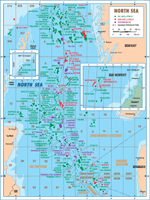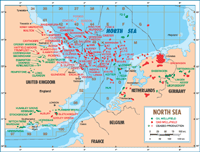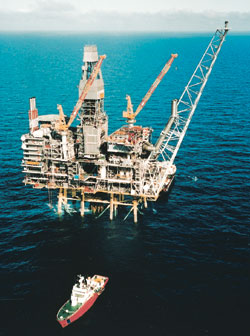Western Europe: United Kingdom
Aug. 2001 Vol. 222 No. 8 International Outlook WESTERN EUROPE Exploration targets becoming smaller North Sea drilling and development is focusing on satellite fields with
WESTERN EUROPEExploration targets becoming smallerNorth Sea drilling and development is focusing on satellite fields with moderate reserves, but lower costsNorth Sea portions written by Arthur Andersen-Petroleum Services Group, London United KingdomLicensing. Following signing of an agreement establishing the boundary between the UK and Faroese sectors in the "White Zone" area of the North Sea, the UKCS Nineteenth Licensing Round was announced by the Department of Trade and Industry (DTI) in the second half of 2000. The area is considered environmentally sensitive due to possible impact of exploration activity on marine habitats / species. The deadline for completion of bids was February 27, 2001, and out of a total 45 blocks or part-blocks offered, DTI announced that it had received 13 applications from 15 companies covering a total of 12 blocks. The blocks were awarded and acceptances received, with awarding of the licenses effective from June 1, 2001. Amerada Hess has been awarded operatorship of four licenses encompassing five blocks; Texaco was awarded three license areas, also covering five blocks; while both Phillips and BP were awarded one license each.
The first half of 2001 has seen a drive in boosting exploration / development in the North Sea. On January 15, 2001, the "LIFT Inspired Farm-in Event" or "LIFE" scheme was launched. Sponsored and created by UKOOA, and supported by Pilot Brindex and the Non-Operators Forum (NOF), this scheme is expected to stimulate / encourage exploration in the North Sea, offering the opportunity for licensees to enhance their portfolios. Drilling. Between July 1, 2000, and June 30, 2001, a total of 56 exploration and appraisal wells were spudded in the UK; 34% were exploration wells, 22 were appraisals. Conoco was the most active operator, starting eight wells, with Kerr-McGee and Amerada Hess in second and third place with seven and six spuds respectively. Once again, the Moray Firth is the region in which the most number of new wells have been spudded, accounting for 29% of wells started. Most of the remaining wells were drilled in northern, central and southern areas of the North Sea, with 18, 23 and 21% of the spuds respectively. Exploration. Six new discoveries were announced between July 2000 and June 2001. In July 2000, Kerr-McGee started drilling 9/14a-10 on the Glassel structure in the North Leadon area. The well was sidetracked and 9/14a-10Z encountered oil. Talisman had success in August with an exploration well drilled from Clyde platform; 30/17b-A32 was deviated to the north to investigate the Leven North structure. Oil was encountered and the well was tied-back to Clyde and completed as a producer. During September, Chevron completed 16/23-6. The well was drilled on the Arundel prospect and is reported to have encountered 70 feet of oil-bearing sands. The final discovery of 2000 was made by Murphy in December. The company drilled 28/3-1 to target a Tertiary objective. After re-spudding the well twice, 28/3-1B encountered oil in a structure thought to have a Tay Formation reservoir. In first-quarter 2001, Conoco drilled an exploration well between Caister and Murdoch fields in the Southern Gas basin; sidetrack 44/22a-10Z encountered 739 ft of gross pay, 170 ft net, in the Carboniferous Westphalian. The accumulation will be developed as part of the Caister Murdoch System III program. During second-quarter 2001, PanCanadian announced discovery of the Buzzard accumulation. BG drilled Well 20/6-3 on the Buzzard prospect on behalf of block-operator PanCanadian. The well encountered oil / gas in the Jurassic and on test, produced 6,547 bopd and 0.97 MMscfd through a 36/64-in.choke. Sidetrack 20/6-3Z is being drilled to further evaluate the find.
Development and production. In 2000, a total of eight fields (Beauly, Blake, Brigantine, Leadon, Jade, Nuggets, Skene and Skiff) containing 279 MMbbl oil and 1.79 Tcf were given development approval, slightly up on the previous year. Three are in the Northern North Sea, two of these are in the Moray Firth, one in the Central North Sea and one in the Southern North Sea. The largest field is Leadon with 150 MMbbl oil. Leadon will be developed using a purchased FPSO. The other fields will be developed as tiebacks to existing infrastructure. Skiff was developed quickly and started production in 2000. In 2000, a total seven fields (Bittern, Cook, Guilemot W and NW, Keith, Shearwater, Skiff and Vixen) containing 323.2 MMbbl oil and 1.31 Tcf came into production. Four of these are in the Central North Sea, two in the Southern North Sea and one in the Northern North Sea. Three of the fields are developed by FPSOs, three others are developed as tiebacks to existing infrastructure. In 2000, total liquids
production reached 962 MMbbl, 5% down on the previous years’ production. This was an average rate of 2.6
MMbpd. Gas production rose on the previous years’ by 9% to 4.07 Tcf, with average daily production of
11.1 Bcfd.
|
||||||||||||||||||||||||||||||||||||||||||||||||||||||||||||||||||||||||||||||||||||||||||||||||||||||||||||||||||||||||||||||||||||||||||||||||||||||||||||||||||||||
- Applying ultra-deep LWD resistivity technology successfully in a SAGD operation (May 2019)
- Adoption of wireless intelligent completions advances (May 2019)
- Majors double down as takeaway crunch eases (April 2019)
- What’s new in well logging and formation evaluation (April 2019)
- Qualification of a 20,000-psi subsea BOP: A collaborative approach (February 2019)
- ConocoPhillips’ Greg Leveille sees rapid trajectory of technical advancement continuing (February 2019)





